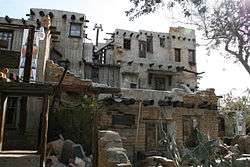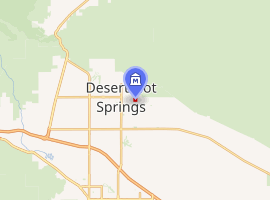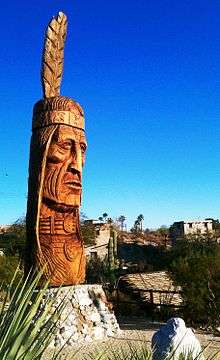Cabot's Pueblo Museum
Cabot's Pueblo Museum (also known as Cabot's Old Indian Pueblo Museum, Cabot's Trading Post and Yerxa's Discovery) is a historic house museum located in Desert Hot Springs, California, United States. A large, Hopi-style pueblo, built in the Pueblo Revival Style, it contains artworks, artifacts of American Indian and Alaska Native cultures, and memorabilia of early desert homesteader life.
 Pueblo Museum – Main Building | |

| |
| Established | 1945 |
|---|---|
| Location | 67-616 East Desert View Ave. Desert Hot Springs, California 33°57′29″N 116°28′56″W[1] |
| Type | Historic house museum |
| Visitors | 10,000+ per year (2009)[2] |
| Curator | Cabot's Museum Foundation |
| Public transit access | SunLine Transit Agency Line 14 |
| Website | www |
Origins of the name
The house and surrounding structures were self-built by Cabot Abram Yerxa (1883–1965),[3] an early 20th-century homesteader in the Coachella Valley.[nb 1] It is named as "Cabot’s Old Indian Pueblo Museum" in its application for listing on the National Register of Historic Places.[4] The California State Parks Office of Historic Preservation lists it as "Yerxa's Discovery".[5][6]
History
Yerxa was an adventurer who first settled on the 160-acre (65-hectare) plot in 1913.[7] Using pick and shovel to dig wells, Yerxa discovered two separate aquifers separated by the Mission Creek Fault[8] (a branch of the San Andreas Fault) atop what would later be called "Miracle Hill." The first aquifer was a natural hot spring with a temperature of 110 °F (43 °C) in the Desert Hot Springs Sub-Basin[9] and which would later help give rise to the area's spas and resorts. The second, on the opposite side of the fault, was a cold aquifer of the Mission Springs Sub-Basin.[10] This same aquifer provides fresh water to the city of Desert Hot Springs and has received awards for exceptional taste.[11][12]
After 24 years of construction, and fashioning it as a Hopi Indian pueblo in honor of the Indian people,[13] Yerxa opened "Cabot's Old Indian Pueblo" in 1945. He operated it with his wife, Portia, until his death in 1965. Upon his death Portia returned to her native Texas and the structure was abandoned.
Yerxa's friend Cole Eyraud protected the settlement after his death and after it had been abandoned and vandalized.[nb 2] Eyraud and his family purchased the complex, restoring it and later donating it to the City of Desert Hot Springs.[14]
Architecture
The centerpiece of the complex is a large, Hopi-style pueblo, in the Pueblo Revival Style of architecture. The main building is a four-story, 5000 square foot (465 sq.m) structure with 35 rooms, 150 windows, 65 doors and 30 different roof levels.[15] The pueblo and all the outbuildings on the site were built primarily from scrap wood and sheet metal all scavenged from the surrounding desert by Yerxa. It has a system of vents and shafts built into the walls to keep it cool in the summer.[16]
Exhibits

Collections
Among the collections of the museum are:
- America Indian and Alaska Native artifacts,[17] including Native American pottery[18]
- Artwork of Yerxa[19][20]
- Documents, including photographs and Yerxa related correspondence[21]
Waokiye
A later addition to the site is that of the Waokiye, or "traditional helper" in the Lakota language. Waokiye is the twenty-seventh sculpture in a series of 74 giant Native American heads, collectively known as the Trail of the Whispering Giants, carved during a twenty-one-year period by artist Peter Wolf Toth. The 43-foot sculpture was carved with the use of power tools from a section of a 45-ton (46 metric ton) giant sequoia log.[22] The 750-year-old tree, which originally stood in Sequoia National Park, had been felled by lightning in the mid-1950s. All but the feather in Waokiye's headband was carved from the log. The feather was carved from an incense cedar from the nearby mountain community of Idyllwild. The statue was unveiled on May 20, 1978; it was repaired and rededicated by Toth on February 21, 2009.[23] At present, it is the only one of the sculptures left in California.[24]
Operations
Owners
The City of Desert Hot Springs owns the museum and it is operated by the Cabot's Museum Foundation, a non-profit corporation.[25] Cabot's Museum Foundation is a member of the American Alliance of Museums.[26]
Cabot’s Trading Post & Gallery
In 2008 the Museum Foundation opened "Cabot's Trading Post & Gallery" to feature artwork from local artists.[27]
Location
The museum is located at 67-616 East Desert View Avenue, in Desert Hot Springs, California, a spa resort town north of Palm Springs, California. Line 14 of the SunLine Transit Agency serves Desert Hot Springs from Palm Springs.
Solar panels
A set of 24 solar panels on a nearby hillside provides electric power to the museum.[28]
Future plans
The museum is developing plans to expand visitor facilities including an amphitheater, hiking trails, and a cultural campus.[29]
Preservation of artifacts
In 2009 numerous artifacts from the pueblo were removed to an undisclosed location.[30] In 2010 the Balboa Art Conservation Center of San Diego, California, conducted a study of the museum and reported that improvements in air filtration, lighting, and landscape irrigation were needed.[31][32] In 2010 the Balboa Art Conservation Center of San Diego, California, conducted a study of the museum and reported that improvements in air filtration, lighting, and landscape irrigation were needed.[33]
Notes
- Yerxa was born on a Lakota Sioux reservation in the Dakota Territory. Before starting the Pueblo, he traveled to Alaska to sell cigars during the Nome Gold Rush, Cuba to develop real estate, and Mexico. His family owned an orange grove in Riverside, California, but lost the crop to freezing in 1913. During World War I, he served in the U.S. Army. Later he worked as the postmaster of Sierra Madre, California. His parents were long established in New England and New Brunswick. (Brown 2011, pp. 11–12.)
Yerxa also subdivided property to create the town of Desert Hot Springs. (Niemann, Greg (2006). Palm Springs Legends: creation of a desert oasis. San Diego, CA: Sunbelt Publications. p. 189. ISBN 978-0932653741. OCLC 61211290. (here for Table of Contents))
The Palm Springs Unified School District Cabot Yerxa Elementary School in Desert Hot Springs is named in his honor. - Cole Eyraud was a Burbank businessman who knew Yerxa in the past. Upon discovering the abandoned Pueblo, he purchased the complex and established Landmark Conservators to preserve the landmark. (Landmark Conservators, California Secretary of State Entity Number: C0561941, Filed: 01/29/1969 Archived 2010-04-02 at the Wayback Machine) (Minckler 1986, p. 23.)
References
- U.S. Geological Survey Geographic Names Information System: Cabots Old Indian Pueblo and Museum
- O’Keefe, Michael (October 2009). "President's Corner: Where We've Been...Where We're Going" (PDF). What's Up on Miracle Hill: News of Cabot's Pueblo Museum, Vol. II, No. 2. Cabot's Pueblo Museum. Archived from the original (PDF) on April 25, 2012. Retrieved November 8, 2011.
- Palm Springs Cemetery District, "Interments of Interest"
- California Department of Parks and Recreation "National Register of Historic Places Registration Form" (Draft)
- California Office of Historic Preservation, "Yerxa's Discovery"
- Guide to the Historical Landmarks of Riverside County, California. Riverside, CA: Riverside County Historical Commission Press. 1993. p. 129.
- Japenga, Ann (March 2007). "Love Letters (and numbers)" (PDF). Desert Magazine. Palm Springs Desert Museum. Retrieved November 28, 2011.
- Mission Springs Water District: hot water maps
- June, Susan (May 5, 2008), The Coachella Valley Basin, Emporia State University, Department of Earth Sciences, retrieved November 14, 2011 – describes the geologic sub-basins
- Mission Springs Water District: sub-basins map
- Berkeley Springs International Water Tasting Awards
- City of Desert Hot Springs – Water
- Bogert, Frank M. (2003). Palm Springs: First Hundred Years (Revised, with epilogue). Palm Springs, CA: Palm Springs Library. p. 161. ISBN 096187242X. OCLC 17171891.
- Cabot's Pueblo Museum official website
- Murray, Tom (March 1964), "Cabot Yerxa's Castle" (PDF), Desert Magazine, p. 29, archived from the original (PDF) on 2011-12-02, retrieved November 11, 2011
- Kraus, Joe (March 1976), "Cabot Yerxa's Monument to the Hopi" (PDF), Desert Magazine, pp. 6–7, archived from the original (PDF) on 2011-12-02, retrieved November 11, 2011
- Honore, Marcel "Treasure trove of artifacts found in Desert Hot Springs museum", Desert Hot Springs Chamber of Commerce
- Pojawa, Jane (July 30, 2010). "Inventory of Cabot's Pueblo Museum Pottery"
- Maron, Barbara C. (2008). Cabot Yerxa, a Life in Art. Desert Hot Springs, CA: Cabot's Museum Foundation. While living in Sierra Madre, Yerxa studied with Anthony Anderson, art critic of The Los Angeles Times. In 1925 he studied at the Paris Académie Julian and the London Murches. Cowboy painter Burt Proctor and Roy Ropp, creator of the Laguna Beach Pageant of the Masters, were frequent guests of Yerxa.
- "A self-described desert rat and trader, in 1925 he went to Paris to study art at Académies Julian and Colarossi." Hughes, Edan Milton (1989). Artists in California 1786–1940 (Second ed.). San Francisco: Hughes Publishing Company. p. 625. ISBN 0961611219. OCLC 123205388.
¶ PF [Ferndinand Perret Files]; The Western Woman, vol. 14, no. 3;
- "A self-described desert rat and trader, in 1925 he went to Paris to study art at Académies Julian and Colarossi." Hughes, Edan Milton (1989). Artists in California 1786–1940 (Second ed.). San Francisco: Hughes Publishing Company. p. 625. ISBN 0961611219. OCLC 123205388.
- Hughes, Edan Milton (1989). Artists in California, 1786–1940. v. 2: Cabot Abram Yerxa. San Francisco: Hughes Pub. Co. p. 637. ISBN 0961611219. LCCN 89086054. OCLC 123205388. LCC N6530.C2 H8 1989
- Brown, Richard E. (editor); Yerxa, Cabot Abram (2011), On the Desert Since 1913, Desert Hot Springs: Cabot's Museum Foundation, ISBN 978-0615455709CS1 maint: extra text: authors list (link) – a partial compilation of Yerxa's articles published in the Desert Hot Springs Desert Sentinel from 1951 to 1957; includes photographs and commentary
- "Artist's statues honor Indians in all 50 states". Cape Coral Daily Breeze. Cape Coral, FL. AP. April 9, 2009. Retrieved November 8, 2011.
- "Waokiye Statue Re-dedicated at Cabot Museum Art Fest". Desert Local News. Palm Springs, CA: Max Liebermann. February 26, 2009. pp. 8–12. Retrieved November 8, 2011.
- Listing of the museum's Waokiye sculpture at Dcschumaker.com
- California Secretary of State Archived 2010-04-02 at the Wayback Machine Entity search, Entity Number C2371784, filed 12/07/2001
- "AAM Membership Directory". Archived from the original on 2012-04-25. Retrieved 2020-07-11.
- O’Keefe, Michael (March 2008). "President's Corner: Cabot Yerxa and the Renaissance of Desert Hot Springs" (PDF). What's Up on Miracle Hill: News of Cabot's Pueblo Museum, Vol. I, No. 2. Cabot's Pueblo Museum. Retrieved November 8, 2011.
- "Maron, Barbara (2010) "The Oldest Green Museum in America", Cabot's Museum Foundation Board" (PDF). Archived from the original (PDF) on 2010-07-05. Retrieved 2011-11-08.
- Bauer and Wiley, Architects; Jones & Jones, Architects (August 2010), Cabot's Pueblo Museum: Site Master Plan: Executive Summary, retrieved November 11, 2011
- Eaton, Michelle (November 10, 2011). "Where Are Cabot's Treasures?". Desert Star Weekly. Desert Hot Springs, CA: Praxis Communications, Inc.: 3, 8. Archived from the original on April 26, 2012. Retrieved December 4, 2011.
Not long after DHS city manager Rick Daniels began his job he identified the most valuable possessions the city owned and hauled them off to an unknown location.
- Schwartz, Hans-Gustav (November 30, 2011). "Preserving the Past – Or NOT? Report Recommended Cabot's Museum Action Plan". Desert Star Weekly. Desert Hot Springs, CA: Praxis Communications, Inc.: 3, 6. Archived from the original on April 26, 2012. Retrieved December 4, 2011.
- Gray, Dean (November 11, 2011). "Where Are Cabot's Treasures?". Desert Vortex. Archived from the original on October 18, 2012. Retrieved October 15, 2012.
- Gray, Dean; Hans Gustaf-Schwartz (December 3, 2011). "Preserving the Past – Or NOT? Report Recommended Cabot's Museum Action Plan". Desert Vortex. Archived from the original on October 18, 2012. Retrieved October 15, 2012.
Bibliography
- Minckler, Karen; Bethany, Schroeder; Cole, Eyraud (1986). The Legend of Cabot Yerxa. Desert Hot Springs, CA: Cabot's Museum Foundation. OCLC 272397224.
- Raef, Laura (February 1970), "White Man's Pueblo" (PDF), Desert Magazine, pp. 8–9, 37, archived from the original (PDF) on 2011-12-02, retrieved November 11, 2011
- Reprinted as Raef, Laura (February 1984), "White Man's Pueblo" (PDF), Desert Magazine, pp. 18–19, archived from the original (PDF) on 2011-12-02, retrieved November 11, 2011
- Roy, George M. (November 1952), "Cabot Yerxa's Crazy House" (PDF), Desert Magazine, 15 (11), pp. 9–11, archived from the original (PDF) on 2011-12-02, retrieved November 11, 2011; Also available at: .
Further reading
- Coffee, L. W. (2008) [First published 1948]. Desert Hot Springs: Why?. Desert Hot Springs, CA: Cabot's Museum Foundation.
- Effinger, Bill (2011). The Vortex Made Me Do It! : The Mystery and History of Desert Hot Springs. San Marcos, CA: New Century Publishing. p. 486. ISBN 978-0615470207.
- Hunt, John J. (2006). The Waters of Comfort (The History of Desert Hot Springs California) (revised and updated ed.). Little Morongo Press. p. 275. ASIN B000W6EMS8. OCLC 52917018.
- Japenga, Ann (March 2007). "Rearview: Love Letters (and numbers). Eccentric Cabot Yerxa wooed a teacher of metaphysics with symbolism". Palm Springs Life. Palm Springs, CA: Desert Publications, Inc.
- Japenga, Ann (December 2007). "Rear View – Companions in Exploration: Early prospectors relied heavily on beasts of burden". Palm Springs Life. Palm Springs, CA: Desert Publications, Inc. Retrieved December 20, 2011.
- Maron, Barbara (Spring 2011). Herron, Keith; Lech, Steve (eds.). "Cabot Yerxa". The Riverside County Chronicles. Riverside County Historical Association; Riverside County Regional Park and Open-Space District (4): 23–25.
- Pojawa, Jane, What's Up on Miracle Hill (index)
- Schulman, Sandra Hale (February 9, 2009). "Cabot's Pueblo Museum a real hot spot". News from Indian Country. Indian Country Communications. 23 (3): 1. ISSN 1548-4939.
- Toth, Peter Wolf (1983). Indian Giver. Cable, WI: Tribal Press. p. 216. ISBN 0960704426. OCLC 12664657. LCC NB237.T635 A4 1983
- Wampler, Jan (1978). All Their Own: People and the Places They Build (reissue ed.). Oxford, New York: Oxford University Press. pp. 122–129. ISBN 978-0195200287. OCLC 2346974. LCC TH4812 .W35 1978
- Yerxa, Cabot Abram (September 2011). "Miracle in the Sand: The words of a pioneer reveal a love for land that demanded respect, patience – and fortitude". Palm Springs Life. Palm Springs, CA: Desert Publications, Inc. Retrieved December 20, 2011.
External links
- Cabot's Pueblo Museum website
- Balboa Arts Conservation Center, about
- DHS Historical Society, "The History of Desert Hot Springs"
- Huell Howser Productions, Palm Springs Series, Show 17, Huell Howser's PBS California's Gold 2002 visit to Cabot's Adobe (available as a VHS videorecodging – OCLC 47724845)
- Also available at: Howser, Huell (September 26, 2002). "Cabot's Adobe – Palm Springs Week (17)". California's Gold. Chapman University Huell Howser Archive.
- Pojawa, Jane (June 4, 2008), "Cabot Yerxa: True Confessions of a Research Addict" retrieved November 8, 2011
- Pojawa, Jane (June 24, 2007). "Sgt Cabot Abram Yerxa". Pioneer. Find a Grave. Retrieved June 30, 2011.